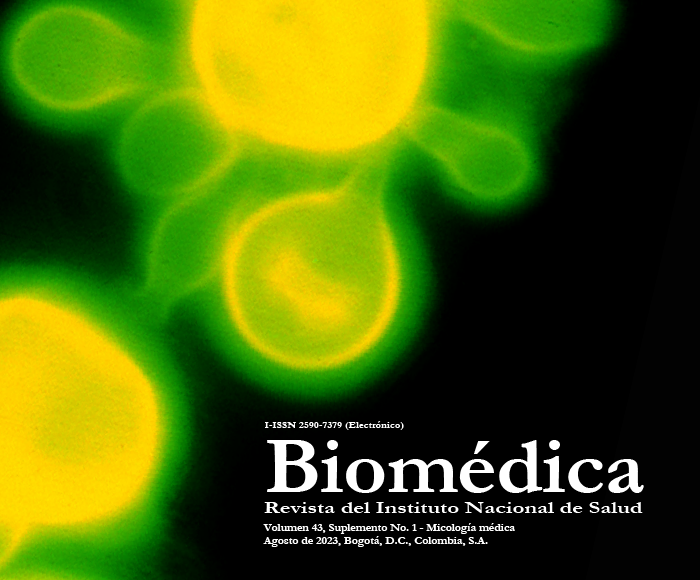Tinea capitis outbreak and other superficial mycosis in an urban community of Medellín
Abstract
Introduction. Dermatophytoses are superficial fungal infections of the keratinized epithelium like tinea capitis. The latte mainly affects school-vulnerable populations. Carpinelo is a peripheral neighborhood in Medellín with poor socioeconomic conditions and where a suspected tinea capitis outbreak took place.
Objective. To study and characterize, clinically and microbiologically, patients with suspected dermatophytosis in Carpinelo.
Material and methods. We carried out a descriptive and longitudinal study with an active case search of tinea capitis in children and their relatives from the Jardín Educativo Buen Comienzo community in Carpinelo. Patients were clinically evaluated, and samples of scales and hair were taken to perform mycological studies with a 10 % potassium hydroxide and culture in Sabouraud and Mycosel agar. We analyzed the data with the statistical program SPSS™. 25 version.
Results. Fifty-seven individuals were studied: 47 were children with a mean age of six years and a ratio of 2:1 male to female. Patients with confirmed diagnosis presented the following clinical forms: tinea capitis (78.95%), tinea faciei (15.79%) or tinea corporis (10.52%). Out of the total, 69.76% of the patients had previous treatment with steroids. The direct test was positive in 53.84% of the samples, and 46.15% had positive cultures. The isolated species were: Microsporum canis (77.77%), Trichophyton spp. (11.11%), Trichophyton rubrum (5.55%), and Malassezia spp. (5.55 %).
Conclusion. Tinea capitis was the most common clinical form, and M. canis was the most frequently isolated species. The use of steroids as the first and only option for empiric treatment was worth of notice. The findings of this study point out the importance of microbiological diagnosis in choosing the best treatment for the patients.
Downloads
References
Negroni, R. Historical aspects of dermatomycoses. Clin Dermatol. 2010;28:125-32. https://doi.org/10.1016/j.clindermatol.2009.12.010
Hay RJ. Tinea capitis: Current status. Mycopathologia. 2017;182:87-93. https://doi.org/10.1007/s11046-016-0058-8
Sahoo AK, Mahajan R. Management of tinea corporis, tinea cruris, and tinea pedis: A comprehensive review. Indian Dermatol Online J. 2016;7:77-86. https://doi.org/1010.4103/2229-5178.178099
Rubio MC, Rezusta A, Gil-Tomás J, Ruesca RB. Perspectiva micológica de los dermatofitos en el ser humano. Rev Iberoam Micol. 1999;16:16-22.
Dogo J, Afegbua SL, Dung EC. Prevalence of Tinea capitis among school children in Nok Community of Kaduna State, Nigeria. J Pathog. 2016;2016:9601717. https://doi.org/10.1155/2016/9601717
Havlickova B, Czaika VA, Friedrich M. Epidemiological trends in skin mycoses worldwide. Mycoses. 2008;51:2-15. https//doi.org/10.1111/j.1439-0507.2008.01606.x
Zhan P, Liu W. The changing face of dermatophytic infections worldwide. Mycopathologia. 2017;182:77-86. https//doi.org/10.1007/s11046-016-0082-8
Ameen M. Epidemiology of superficial fungal infections. Clin Dermatol. 2010;28:197-201. https//doi.org/10.1016/j.clindermatol.2009.12.005
Hawkins DM, Smidt AC. Superficial fungal infections in children. Pediatr Clin North Am. 2014;61:443-55. https//doi.org/10.1016/j.pcl.2013.12.003
Gavilán SM, Montero RSG. Dermatofitosis en estudiantes de la Institución Educativa “San Juan de la Frontera”, Ayacucho, Perú, 2010. Rev Peru Epidemiol. 2011;15:65-8.
Alvarado Z, Pereira C. Fungal diseases in children and adolescents in a referral centre in Bogota, Colombia. Mycoses. 2018;61:543-8. https//doi.org/10.1111/myc.12774
Alemayehu A, Minwuyelet G, Andualem G. Prevalence and etiologic agents of dermatophytosis among primary school children in Harari Regional State, Ethiopia. J Mycol. 2016. https://doi.org/10.1155/2016/1489387
Mishra N, Rastogi MK, Gahalaut P, Yadav S, Srivastava N, Aggarwal A. Clinico-mycological study of dermatophytoses in children: presenting at a tertiary care center. Indian J Paediatr Dermatol. 2018;19:326-30. https://doi.org/10.4103/ijpd.IJPD_98_17
Ameen M. Epidemiology of superficial fungal infections. Clin Dermatol. 2010; 28: 197-201. https://doi.org/10.1016/j.clindermatol.2009.12.005
Sacheli R, Harag S, Dehavay F, Evrard S, Rousseaux D, Adjetey A, et al. Belgian National Survey on Tinea capitis: Epidemiological considerations and highlight of terbinafine-resistant T. mentagrophytes with a mutation on SQLE gene. J Fungi (Basel). 2020;6:195. https://doi.org/10.3390/jof6040195
Arenas R, Torres E, Amaya M, Rivera ER, Espinal A, Polanco M, et al. tinea capitis. Emergencia de Microsporum audouinii y Trichophyton tonsurans en la República Dominicana. Actas Dermosifiliogr. 2010;101:330-5. https://doi.org/10.1016/j.ad.2009.12.004
Zuluaga A, Cáceres DH, Arango K, de Bedout C, Cano LE. Epidemiología de la Tinea capitis: 19 años de experiencia en un laboratorio clínico especializado en Colombia. Infectio. 2016;20:225-30. https://doi.org/10.1016/j.infect.2015.11.004
Kechia EA, Kouoto EA, Nkoa T, Nweze EI, Fokoua DC, Fosso S, et al. Epidemiology of Tinea capitis among school-age children in Meiganga, Cameroon. J Mycol Med. 2014;24:129-34. https://doi.org/10.1016/j.mycmed.2013.12.002
Metintas S, Kiraz N, Arslantas D, Akgun Y, Kalyoncu C, Kiremitci A, et al. Frequency and risk factors of dermatophytosis in students living in rural areas in Eskisehir, Turkey. Mycopathologia. 2004;157:379-82. https://doi.org/10.1023/b:myco.0000030447.78197.fb
Lakhani SJ, Bilimoria SJ, Lakhani JD. Adverse effects of steroid use in dermatophytic infections: A cross sectional study. J Integr Heal Sci. 2017;5:63-8. https://doi.org/10.4103/2347-6486.240248
Erbagci, Z. Topical therapy for dermatophytoses: Should corticosteroids be included? Am J Clin Dermatol. 2004;5:375-84. https://doi.org/10.2165/00128071-200405060-00002
Wheat CM, Bickley RJ, Hsueh Y-H, Cohen BA. Current trends in the use of two combination antifungal/corticosteroid creams. J Pediatr. 2017;186:192-5. https://doi.org/10.1016/j.jpeds.2017.03.031
Alston SJ, Cohen BA, Braun M. Persistent and recurrent tinea corporis in children treated with combination antifungal/ corticosteroid agents. Pediatrics. 2003;111:201-3. https://doi.org/10.1542/peds.111.1.201

Copyright (c) 2023 Biomedica

This work is licensed under a Creative Commons Attribution 4.0 International License.
| Article metrics | |
|---|---|
| Abstract views | |
| Galley vies | |
| PDF Views | |
| HTML views | |
| Other views | |

























